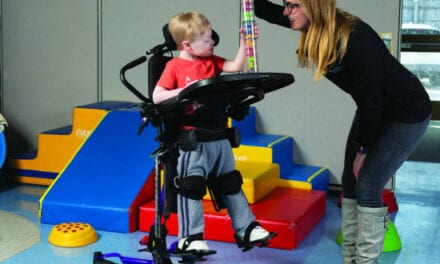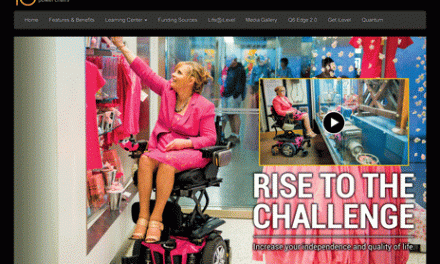New wheeled mobility device users look to therapists to help them navigate the world of complex rehab technologies.
by Cynthia Petito, OTR/L, MBA, ATP, CAPS, CEAC
With recent advances in complex rehab technology (CRT), there is a wider range of manual wheelchair frames, power wheelchair bases, and smart technologies to choose from that offer custom features and configurations. Individuals and their families who are new to wheeled mobility will be overwhelmed by the choices presented during their first visit to a wheelchair clinic. New end-users, who will be using the recommended mobility products, will look to wheeled mobility-seating clinicians to make most of the decisions regarding their first wheeled mobility device. This article provides an overview of CRT, including manual and power mobility and smart technology available to end-users. An overview of the Medicare coverage criteria is also outlined to assist clinicians with understanding the documentation requirements.
CRT & The Mobility Limitation
CRT products and services include medically necessary, individually configured manual and power wheelchair systems, adaptive seating systems, alternative positioning systems, and other mobility technologies that require evaluation, fitting, configuration, adjustment, or programming to meet individual needs. CRT includes many levels of manual and power wheelchair devices and is most often considered for individuals with neurological conditions and injuries and congenital diseases. When evaluating patients for mobility devices, clinicians must assess the complications and limitations that warrant the need for a manual or power wheelchair. The evaluation should not be based solely on the clinician’s observation of the patient’s ability to ambulate. Clinicians must use objective measures and standardized tests to evaluate the functional limitations in ambulation and mobility-related activities of daily living (MRADLs) which involve the patient and family and/or caregivers.
Individuals with progressive neuromuscular and neurodegenerative diseases can be challenging to evaluate depending on the stage of the patient’s disease. Clinicians must be knowledgeable about condition and understand the disease progression and associated functional impairments to recommend the most appropriate mobility device. Traumatic neuromuscular injuries such as spinal cord injuries (SCI) are usually more evident in evaluating mobility needs. With slower progressive diseases such as multiple sclerosis, a new end-user will need a manual wheelchair once lower extremity weakness, impaired motor coordination, gait instability, and falls become problematic. However, this same end-user may need a power wheelchair after several years due to progressing muscle weakness and motor incoordination along with significantly impaired gait and balance or the inability to ambulate. With faster progressive diseases such as Lou Gehrig’s disease (ALS), a new end-user will most likely need a power wheelchair as their first mobility device because clinicians must stay ahead of the disease progression to maintain safe mobility and maximize independence.
Reducing falls is vital for persons with ALS because recovery from a serious fall injury is not likely and falls can lead to additional permanent loss of physical abilities. Furthermore, if the ALS disease primarily affects the upper extremities but the patient can still stand and ambulate short distances, power mobility is still indicated because of the upper body weakness and significant balance impairments; the individual becomes “top-heavy” with increased risk of falls. In this situation, if the clinician observes the patient ambulating without considering the upper body weakness, fatigue, imbalance, and falls risks associated with ALS, he or she may mistakenly defer the recommendation of power mobility needs if their evaluation is based solely on observation of walking distance.
Other mobility limitations may occur due to cognitive impairments related to progressive diseases such as Alzheimer’s and Parkinson’s. Both diseases impact muscle strength, but also deteriorate cognitive function. Declined cognition is another indicator for manual mobility when patients experience gait instability with impaired judgment and safety awareness, which increase fall risks.
Individuals with congenital disorders, such as cerebral palsy (CP), may use canes, forearm crutches, or custom walkers to ambulate during their childhood and young adulthood years. As they age, they may need a custom configured manual or power wheelchair to stay active and independent through their lifespan.
Overview of Complex Rehab Manual Frames and Power Bases
Manual Wheelchair Frames
When considering a manual wheelchair frame, clinicians must account for the wheelchair frame weight and fit, additional weight of the seating system and accessories, and the end-user’s weight and body size (seating measurements) to maximize safe, independent and functional wheelchair propulsion. Clinicians who are interested in wheelchair seating and mobility assessments and applications beyond this article can refer to the publication, Seating and Wheeled Mobility: A Clinical Resource Guide.3
High-Strength Lightweight Manual Frame (K0004)
These lightweight frames are less than 34 pounds and available in various sizes with features such as adjustable-height armrests and leg rests and individually configured seat heights, seat depths, and back heights outside the standard sizes. They can accommodate an end-user weight up to 300 pounds. Clinicians can consider a high-strength lightweight manual wheelchair for a new end-user under the following criteria:
• The patient can self-propel the wheelchair while engaging in frequent MRADLs in the home that cannot be performed in a standard weight (K0001) or standard lightweight wheelchair (K0002); OR
• The patient requires a seat width, depth, or height that cannot be accommodated in a standard weight (K0001), hemi-wheelchair (K0002), or standard lightweight (K0003), and spends at least 2 hours per day in the wheelchair.
• A high-strength lightweight wheelchair is rarely reasonable and necessary if the expected duration of need is less than 3 months (eg, postoperative recovery).1
An example would be an individual who suffered a stroke and does not have the strength or activity tolerance to complete their MRADLs at the ambulatory level independently and safely.1
Ultra Lightweight Manual Frame (K0005)
Ultra lightweight frames are less than 30 pounds. They have an adjustable axle plate not offered on high-strength lightweight frames. These frames come in adult and pediatric sizes. They are custom fitted and come in a cross-frame style and rigid-frame style. These wheelchairs are the lightest in weight, and have the greatest amount of adjustability to properly customize the wheelchair for the individual. They can accommodate an end-user weight up to 250 to 300 pounds. End-users who will need this level of manual mobility are not functional ambulators or are completely non-ambulatory. However, they need wheeled mobility to complete all of their MRADLs both inside their home and within the community. Clinicians can consider an ultra-lightweight manual wheelchair for a new end-user under the following criteria:
• The patient is a full-time manual wheelchair user.
• The patient requires individualized fitting and adjustments for one or more features such as, but not limited to, axle configuration, wheel camber, or seat and back angles, and these fittings/ adjustments cannot be accommodated by a K0001 – K0004 manual wheelchair.
• Documentation supporting the medical necessity for the K0005 includes a specialty evaluation performed by an LCMP such as a PT, OT, or physician with specific training and experience in rehabilitation wheelchair evaluations. The LCMP may have no financial relationship with the supplier.
• The wheelchair is provided by a supplier that employs a RESNA-certified Assistive Technology Professional (ATP) who specializes in wheelchairs and who has direct, in-person involvement in the wheelchair selection for the patient.1
An example would be an individual who sustained a SCI with paraplegia. For these new end-users, the wheelchair becomes a part of their everyday life in their home and community.
Heavy Duty (K0006) and Extra Heavy Duty Frame (K0007)
For patients who weigh more than 250 pounds or more than 300 pounds, these manual wheelchair frames may be considered. These frames are typically very heavy and weigh more than 36 pounds. When combining the wheelchair frame weight and the patient’s weight, self-propulsion may not be functional. It is important for clinicians to consider potential shoulder injuries and other physical demands with related complications for patients who will propel their own body weight greater than 250 pounds.
Manual Tilt-in-Space Frame (E1161-Adult, E1232/E1233-Pediatric)
Tilt-in-Space wheelchair frames come in adult and pediatric sizes, folding and rigid frame styles, and in various weights depending on the configuration. The tilting feature allows for up to 55 degrees of tilt depending on the manufacturer make and model. When needed, a recline feature can be added to the frame to accommodate patients who are in need of both tilt and recline seating.
There are many ways to configure a tilt-in-space wheelchair depending on the goals for end-users and their caregivers. The most common configuration is for those patients who are totally dependent in their daily care and need proper positioning and pressure relief during their daily routine activities. Clinicians may consider a tilt-in-space manual wheelchair for a new end-user under the following criteria:
• A standard manual reclining wheelchair will not meet the patient’s needs (eg, sliding, risk of skin breakdown, postural/spinal deformities).
• Justification of features on a tilt-in-space wheelchair that are not offered on a standard manual reclining wheelchair.
• Documentation supporting the medical necessity for the tilt-in-space frame includes a specialty evaluation performed by an LCMP such as a PT, OT, or physician with specific training and experience in rehabilitation wheelchair evaluations. The LCMP may have no financial relationship with the supplier.
• The wheelchair is provided by a supplier that employs a RESNA-certified Assistive Technology Professional (ATP) who specializes in wheelchairs and who has direct, in-person involvement in the wheelchair selection for the patient.1
Power Options for Manual Mobility
Push-Rim Activated Power Assist Device (E0986)
Power-assisted wheels are mounted on the wheelchair in place of the manual wheels. The batteries are integrated in the wheel hub, and a sensor registers the propelling movement that activates the electrical motors. When the patient propels a certain amount of force, the push rims engage the motors to propel the wheelchair. This power option is beneficial for end-users who will be using their manual wheelchair full time in the community, traveling long distances, or have hills to negotiate. Power assist devices can address potential issues with repetitive shoulder motion such as overuse shoulder syndrome and help patients who have upper extremity weakness. Clinicians may consider power assist devices under the following criteria:
- All of the criteria for a power mobility device listed in the Basic Coverage Criteria section are met; AND
- The patient has been self-propelling in a manual wheelchair for at least one year; AND
- The patient has had a specialty evaluation that was performed by a licensed/certified medical professional, such as a PT or OT, or practitioner who has specific training and experience in rehabilitation wheelchair evaluations and that documents the need for the device in the patient’s home. The PT, OT, or practitioner may have no financial relationship with the supplier; AND
- The wheelchair is provided by a supplier that employs a RESNA-certified Assistive Technology Professional (ATP) who specializes in wheelchairs and who has direct, in-person involvement in the wheelchair selection for the patient.2
Other Power Assist Products
There are several types of power assist devices on the market. One type is a system that incorporates a joystick controller, battery pack, and electric wheels that allow a manual wheelchair to be converted into a lightweight power wheelchair. It is easy to dismantle and ideal for transporting. Another type of power assist product adds a power wheel (third wheel in back of the frame) to the manual wheelchair to propel the wheelchair forward. Both types allow for varying speeds of propulsion and ability to negotiate hills and different types of terrain.
Power Wheelchair Bases
Power wheelchair bases come in three different drive wheel configurations. They can accommodate end-users who weigh up to 600 pounds. There are manufacturers that offer bariatric power wheelchairs for end-users who weigh up to 1,000 pounds. When evaluating for power mobility, clinicians must consider patients’ environments both inside and outside their home, as well as their means of transporting the power device in the community.
Medicare outlines the coverage criteria of power wheelchairs under categories Group 1 to Group 5 and are based on the weight capacity of the power base, the number of power seating functions, and patients’ diagnoses.
Front-Wheel-Drive Base (FWD)
A front-wheel-drive power base is manufactured with the drive wheel located in the front of the wheelchair base. This base does well in obstacle climbing and overall stability when negotiating different types of terrain. FWD bases are known for fishtailing when driven at high speeds. The turning radius of a FWD falls in the middle when compared to a rear-wheel- and mid-wheel-drive base. The turning radius of a FWD is typically smaller than a rear-wheel power base, but larger than a mid-wheel power base. Because the drive wheel is in the front of the base, the FWD configuration allows for turns around tight 90-degree corners; however, the end-user has to account for the rear caster wheel space of the power wheelchair, which swings around behind them during the turn.
Mid-Wheel-Drive Base (MWD)
This drive-wheel configuration has the tightest turning radius of the three drive wheel bases. A MWD power wheelchair can turn in a 360-degree circle within the footprint of the wheelchair, which allows for maneuverability in confined spaces inside an end-user’s home. When it comes to outdoor use, the MWD tracks well on unlevel terrain as the drive wheel is in the center of the power base. With six wheels on the ground, end-users who are new to power mobility may feel more stable. In addition, driving a MWD power wheelchair tends to be more intuitive because the drive wheel is under the seat of the individual, creating a center of gravity turn motion that feels similar to turning in place during ambulation.
Rear-Wheel-Drive Base (RWD)
Rear-wheel-drive power wheelchairs are known for handling aggressive terrain and performing well at top speeds. The primary disadvantage of a RWD base is the overall footprint for maneuvering indoors and a large turning radius. When considering a RWD base for a new end-user, the clinician must be sure a RWD is appropriate for maneuverability inside the home, as well as work, school, or other environments the individual engages in throughout their day.
Power Wheelchair Base Coverage & Categories
Clinicians may consider power mobility for new end-users under the following general coverage criteria for all power wheelchair bases.
(NOTE: The criteria does not include the power seating functions, seating systems, and accessories, which have to be justified separately from the power wheelchair bases)
- The patient has a mobility limitation that significantly impairs his/her ability to participate in one or more mobility-related activities of daily living (MRADLs) such as toileting, feeding, dressing, grooming, and bathing in customary locations in the home. A mobility limitation is one that:
• Prevents the patient from accomplishing an MRADL entirely, or
• Places the patient at reasonably determined heightened risk of morbidity or mortality secondary to the attempts to perform an MRADL; or
• Prevents the patient from completing an MRADL within a reasonable time frame.
- The patient’s mobility limitation cannot be sufficiently and safely resolved by the use of an appropriately fitted cane or walker.
- The patient does not have sufficient upper extremity function to self-propel an optimally-configured manual wheelchair in the home to perform MRADLs during a typical day.
• Limitations of strength, endurance, range of motion, or coordination, presence of pain, or deformity or absence of one or both upper extremities are relevant to the assessment of upper extremity function.
• An optimally-configured manual wheelchair is one with an appropriate wheelbase, device weight, seating options, and other appropriate non-powered accessories.2
Group 1 and 2 Power Wheelchairs
It is important to review the Group 1 and Group 2 categories of power wheelchair bases because these devices do not fall under the complex rehab technology category discussed in this article. These consumer level power wheelchairs covered under Medicare are prescribed for patients who do not have complex seating and positioning needs, but need basic power mobility to complete MRADLs in their home. Patients who have debilitating conditions, such as diabetes, osteoarthritis, chronic pain, or cardiopulmonary conditions will benefit from power mobility to reduce falls and maintain independence as they age.
Clinicians may consider power wheelchairs for patients under the general coverage criteria:
- The patient has the mental and physical capabilities to safely operate the power wheelchair that is provided; or
- If the patient is unable to safely operate the power wheelchair, the patient has a caregiver who is unable to adequately propel an optimally configured manual wheelchair, but is available, willing, and able to safely operate the power wheelchair that is provided; and
- The patient’s weight is less than or equal to the weight capacity of the power wheelchair that is provided and greater than or equal to 95% of the weight capacity of the next lower weight class PWC.
- The patient’s home provides adequate access between rooms, maneuvering space, and surfaces for the operation of the power wheelchair that is provided.
- Use of a power wheelchair will significantly improve the patient’s ability to participate in MRADLs and the patient will use it in the home. For patients with severe cognitive and/or physical impairments, participation in MRADLs may require the assistance of a caregiver.
- The patient has not expressed an unwillingness to use a power wheelchair in the home.2
Group 3, 4 and 5 Power Wheelchairs
These groups of power wheelchair bases fall under CRT and are recommended for both pediatric and adult populations. Group 3 power bases (adult) and Group 5 power bases (pediatric) offer power seating options such as power tilt, power recline, power seat elevation, power elevating legs, and power standing. The electronics can accommodate a wide range of customization to meet driving needs using alternative drive control technology. It’s important to note Group 1 and Group 2 power bases do not offer these same electronics and technologies but may accommodate minimal power seating features depending on the manufacturer. Group 4 power bases offer performance capabilities that Medicare does not consider reasonable and necessary such as upgraded power motors to increase the overall speed of a power wheelchair.
The diagnoses of end-users who benefit from Group 3 and 5 power mobility include, but are not limited to, SCI, TBI, progressive neuromuscular and neurodegenerative diseases, and congenital diseases. Clinicians will collaborate with ATPs and must provide documentation to meet the coverage criteria for the power base, electronics, and seating system.
• Documentation supporting the medical necessity for the power wheelchair includes a specialty evaluation performed by an LCMP such as a PT, OT, or physician with specific training and experience in rehabilitation wheelchair evaluations. The PT, OT, or practitioner may have no financial relationship with the supplier.
• The wheelchair is provided by a supplier that employs a RESNA-certified Assistive Technology Professional (ATP) who specializes in wheelchairs and who has direct, in-person involvement in the wheelchair selection for the patient.2
Alternative Drive Controls for Power Mobility
When end-users cannot operate a standard joystick controller with their upper extremities, alternative drive controls must be considered to maximize independence. Clinicians will have to complete an access site assessment. Michelle Lange, OTR/L, ABDA, ATP/SMS, offers resources, such as her Decision Making Tree for Non-Joystick Driving Methods, to help guide clinicians in evaluating for alternative drive controls.4
There are several types of alternative drive controls to trial with a new end-user. Some include head and chin controls, foot controls, sip-n-puff, switch drive, and fiber optics. Some alternative drive controls offer a combination of two alternative drive control methods in one unit. For example, the combination of a head array and sip-n-puff system. In addition, there are proportional and non-proportional controllers and mechanical and proximity switch drive controllers to dial in driving customization for successful, safe, and independent drive capabilities.
Clinicians will have to match the patient’s abilities to the appropriate drive control device depending on the strongest and most reliable access site. For example, an end-user with quadriplegia may have sufficient head/neck control. The clinician can trial a head array, chin control, and sip-n-puff system (or the combination of two) to assess which type the patient feels most comfortable with and with the most success.
Another example would be a patient with ALS who has absent upper extremity function, significantly impaired head/neck control, but functional foot and ankle range of motion and strength. If the foot and ankle are the strongest and most reliable access site, the clinician will want to consider a foot control for the power wheelchair.
Clinicians who are interested in wheelchair seating and mobility assessments and applications beyond this article can refer to the publication, Seating and Wheeled Mobility: A Clinical Resource Guide.3
Smart Technology
In recent years, technology for power wheelchairs has become “smarter” and with custom features to keep power wheelchair end-users safer inside and outside their homes. Each year, there are more than 175,000 ER visits due to wheelchair injuries related to falls and crashes. Smart technology for power mobility uses sensors and cloud-connected software to maintain stability and security by detecting potential hazards in end-users’ environments that will prevent collisions, tipping, and falls.5 These smart safety features operate similarly to the technology in automobiles such as automated emergency braking (AEB) for collision avoidance. As smart technology continues to evolve for mobility devices, end-users will have greater independence and safety while engaging in their environments.
Summary
Both new and experienced end-users should be informed of all their options and choices in equipment regardless of funding limitations and insurance coverage criteria. Clinicians can learn more about CRT by visiting online resources such as the Rehabilitation Engineering and Assistive Technology Society of North America (RESNA), National Registry of Rehabilitation Technology Suppliers (NRRTS), and the National Coalition for Assistive and Rehab Technology (NCART). RM
Cynthia Petito, OTR/L, MBA, ATP, CAPS, CEAC, is the operations manager for Worker’s Compensation & Access at National Seating & Mobility. For more than 20 years, she has specialized in wheeled mobility, complex seating, assistive technology, home safety, and home modifications to keep individuals living independently in their homes and communities throughout their lifespan. For more information, contact [email protected].
References
1. Centers for Medicare and Medicaid Services (2020). Manual Wheelchair Bases: LCD 33788. Retrieved from https://www.cms.gov/medicare-coverage-database/view/lcd.aspx?LCDId=33788&ContrID=140.
2. Centers for Medicare and Medicaid Services (2020). Power Mobility Devices: LCD 33789. Retrieved from https://www.cms.gov/medicare-coverage-database/view/lcd.aspx?lcdid=33789&ver=31&bc=0
3. Lange M and Minkel J, Eds. Seating and Wheeled Mobility: a Clinical Resource Guide. Thorofare, NJ: Slack Incorporated; 2018.
4. Lange M. (2017). Decision Making Tree for Non-Joystick Driving Methods. Retrieved from http://www.atilange.com/resources.html. Accessed January 31, 2018.
5. LUCI (2021). Safety Report. Retrieved from https://luci.com/safe/. Accessed September 12, 2021





